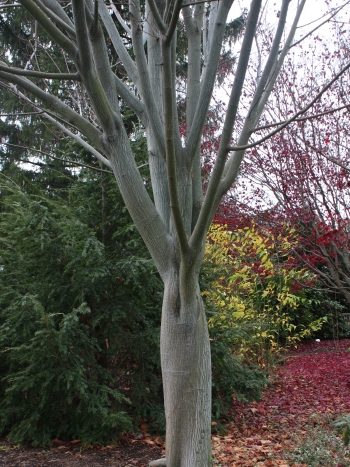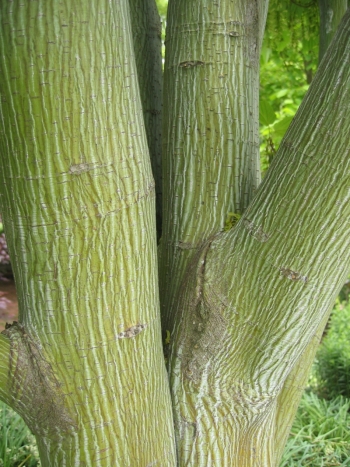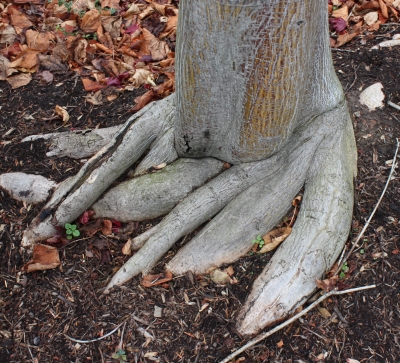Greetings, all!
I am not a tree-care expert, having invested most of my mental capital into herbaceous plant stuff. But I know enough to be dangerous: spiraling/strangling roots and narrow crotch angles are bad news. But at what point do they become “unfixable”? So I’m asking my illustrious colleagues and diligent readers (a.k.a “all y’all) for advice.
We have a lovely specimen in our campus Horticulture Garden…Acer ‘White Tigress’ – a hybrid between A. davidii and A. tegmentosum – also known as snake-bark maple. Probably been in the ground for 18 years or so. Lovely buttery fall color, gorgeous stripey bark.
This tree, as we say in Georgia, “has more problems than a show dog.”
Scroll on down…

Bit of constriction there, mid-way up.

Some interesting crotch angles, too…
But here’s the kicker (I can hear Linda hooting it up from here…)

This poor gal is obviously a “what not to do” teaching tool.
But the question is:
Can this tree be saved? Discuss.
With a root ball like that, I’d start cuttings. Crotch problems like that are also easier to prevent than cure.
Yep, the crotch angles are ridiculous. I don’t think any pruning was ever done to this poor thing. I’m hoping other folks chime in with an “o.k.” to cut some roots…
Clone it and either do some drastic surgery or wait for it to shatter and fail.
The amount of corrective pruning required to “fix” this tree would have a significant effect on many physiological operations performed by the tree. These may prove to be its undoing. Unless the tree has some irreplaceable significance to the owners/community I would suggest removing it a.s.a.p. and starting a new tree in its place. Why delay the inevitable? It’s too bad the problems were not corrected earlier or the tree rejected at planting time.
I’d say the significance of the tree is its utility as a teaching tool, since it is in our campus teaching/display garden.
I’d have to agree that the poor root system spells an early death for this tree. I know at the UW arborteum that cuttings are taken as trees decline so they can be replaced. The uneven structure of the roots will probably mean a blowdown in the future, if diseases don’t colonize the crotches in the crown first. Maybe a good project for your department’s plant propagation class!
Holly, are the poor branching and rooting structures affecting the crown at this point? If so, then I agree that the tree should be removed now. Certainly propagating replacement trees from cuttings is a dandy idea, too. But I wonder if the tree might be able to function just fine for quite a long time without other intervention. It’s not an Acer
palmatum or A. japonicum, but looks as if it might share some of their toughness to endure even crappy structure. I’ve noticed that those maples can look just awful structurally, but are perfectly able to deal indefinitely somehow with included bark and close crotch angles. Roots — they’re iffier here, as it looks as if the tree was planted sideways — but it may be still that for a while, at least, just removing that one ‘legs-crossed’ root (that looks as if it’s split) might be all the intervention necessary. Taking the long view, it might make sense to start cuttings now, plant them out somewhere good, pick the best one a few years down the road, and then replace this one with its offspring. Then the space and light available when this one goes away will be there for the new plant, which at that point will be big enough to have some presence. And in the meantime, use this tree as a cautionary tale to Hort Garden visitors!
Holly, I forgot to ask about the constriction on the trunk. Could there possibly be old staking material that the bark has enveloped? It’s weird!
I know, I know — my last comment was long….but I keep thinking about this tree, and ornamental maples in general. This afternoon’s walk took in some mature sugar maples, which had very narrow crotch angles and lots of them. The thought struck me that, as Linda says, it’s good to know your plants before you go to pick new ones. In my experience, maples may look bad, but they’re pretty tough (excepting Norway maples, which grow so quickly and then break up and drop limbs just when you need them not to), and can live quite a long time without falling apart or developing debilitating pathogenic problems. A few years back I had to pick out some American elms for a project, and DED aside, they also seem to hang together quite well, despite less than good crotch angles. I’m always inclined to tag for planting those trees with the best structure, but it seems to me that even some ‘baddies’ aren’t so bad, and on some genera the branch attachments may be stronger than they look. My random observations over the years have me thinking this way — has anyone seen/thought/noticed this?
Even in all its deformity it is an interesting looking tree and I think – I find the roots particularly fascinating almost as if they were clinging to a rocky crag off the coast of Japan. I agree with Deb, I think some trees are stronger then others based on whether they’re softwooded like a Silver Maple or have a harder wood like an American Elm or Sugar Maple.
Thanks for all the comments and advice! Linda, the constriction does look like it was “staked and forgotten” or something similar. Deb, I think we are going to go ahead and remove the “leg-crossed” root, to see what happens. Regarding crotch angles, I think the Bradford Pear fiasco has made folks extra-leery, having seen so many split in half. You have a point in that some mighty big trees have some less-than-desirable architecture.